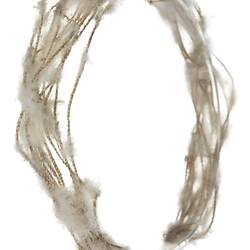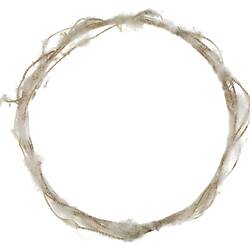Summary
Ornaments made from feathered string are a dominant part of the decorative ceremonial objects made to be worn by both men and women, this type in particular being used in Djungguwan ceremonies, In ancestral times, these were worn by the Wagilag Sisters, who created the Arnhem Land landscape during their travels. The raki, or string, is most often made from the softened and shredded fibres of the inner bark of the Kurrajong (Brachychiton paradoxum). It is produced by rolling two strands of the fibre along the thigh away from the body, and then with a backward rolling motion, pressure is applied with the base of the hand causing the twisted fibres to ply. This has been made using a single continuous length of string wound around to form a circle to a size that sits comfortably on the head, and the feathers were incorporated into the string during the spinning process.
Local Name
mitjpurrkula
Physical Description
A circular band made of a single length of feathered vegetable fibre string wound around a number of times and tied.
More Information
-
Object/Medium
Ornament, head
-
Maker
-
Cultural Groups
-
Locality
Cape Arnhem, Eastern Arnhem Land, Northern Territory, Australia
-
Date Produced
-
Collector
-
Date Collected
-
Object Measurements
260 mm (Length), 170 mm (Width), 45 mm (Height)
-
Classification
-
Date Made
-
Maker
-
Clan/Language Group
-
Place Made
-
Indigenous Region
-
Keywords
-
Acquisition Information
Long-term Loan from The University of Melbourne, 28 Mar 1973
-
Collection Names
-
Type of item
-
Discipline
-
Category
-
Acknowledgement
The Donald Thomson Collection. On loan to Museum Victoria from The University of Melbourne.


